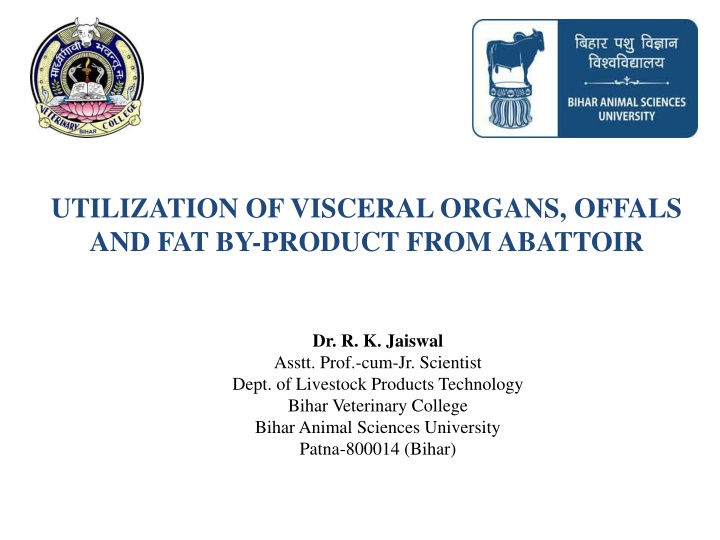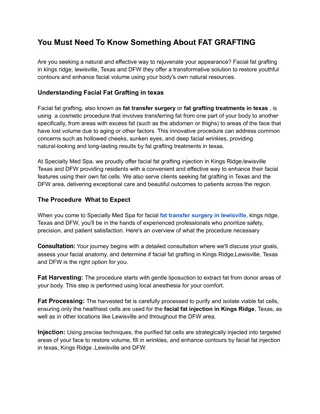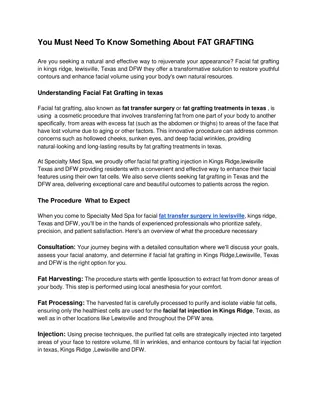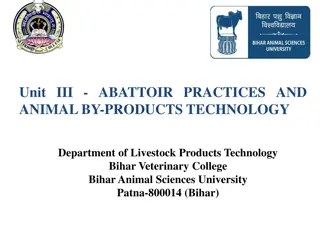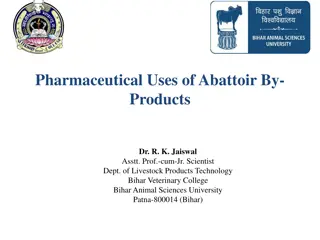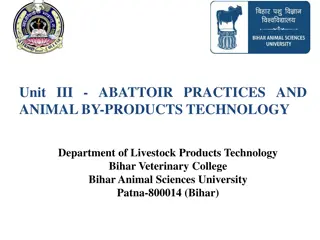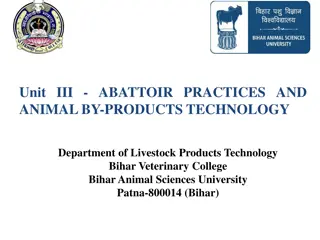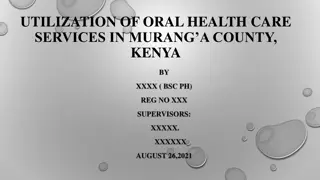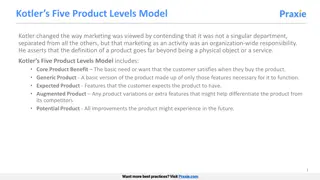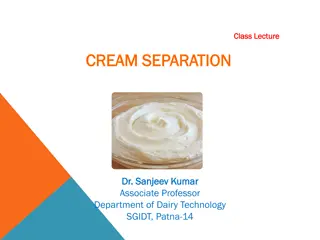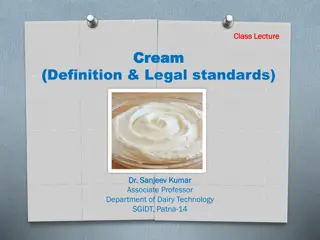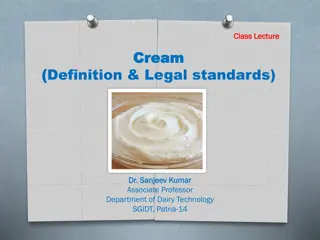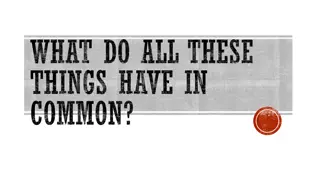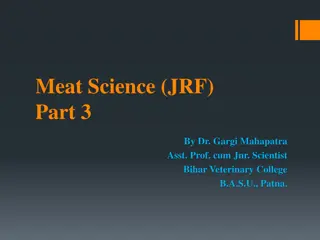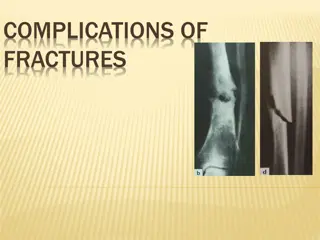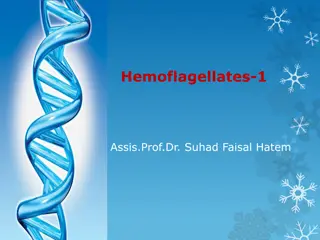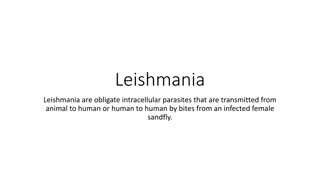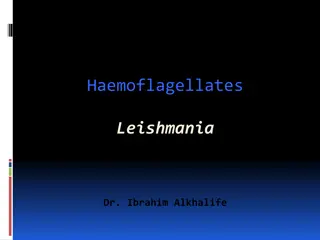Utilization of Visceral Organs, Offals, and Fat By-Product from Abattoir for Livestock Feed
Abattoir offal and visceral organs can be processed into stock feed for livestock, ensuring safe utilization with proper boiling and mixing techniques. Despite some limitations, such methods offer a practical solution for small-scale meat meal manufacture in the livestock industry.
Download Presentation

Please find below an Image/Link to download the presentation.
The content on the website is provided AS IS for your information and personal use only. It may not be sold, licensed, or shared on other websites without obtaining consent from the author.If you encounter any issues during the download, it is possible that the publisher has removed the file from their server.
You are allowed to download the files provided on this website for personal or commercial use, subject to the condition that they are used lawfully. All files are the property of their respective owners.
The content on the website is provided AS IS for your information and personal use only. It may not be sold, licensed, or shared on other websites without obtaining consent from the author.
E N D
Presentation Transcript
UTILIZATION OF VISCERAL ORGANS, OFFALS AND FAT BY-PRODUCT FROM ABATTOIR Dr. R. K. Jaiswal Asstt. Prof.-cum-Jr. Scientist Dept. of Livestock Products Technology Bihar Veterinary College Bihar Animal Sciences University Patna-800014 (Bihar)
VISCERAL ORGANS AND OFFALS Abattoir visceral organs and offals can be utilized as stock feed simply by boiling, which renders them safe to feed to livestock. This has to be done in the following way: All inedible offal, including the condemned parts, is put into a kettle or into oil or petrol drums, which have been split along their longitudinal axis. If the intestinal tract is used, it must first be thoroughly cleaned and washed.
Water, to one and a half time to the weight of the offal, is to be added. The contents are boiled for one hour. All the meats from the bones scraped. Bran, pollards or a similar product is added, equal in weight to the mass, and rigorously stained in. The mixer after cooking for further half an hour should be of a thick porridge consistency, and equivalent to 10% of meat meal.
The disadvantages of processing of above method are: The fat cannot be recovered and used separately. The foodstuff obtained has poor keeping quality and must be used on the day of production or the following day. If a pressure cooker is available, it can be used to digest the offal. Bones present in the offal will yield up the gelatin but the bones must be removed after treatment.
The utilization of offal and/or condemned material is somewhat limited and inefficient unless livestock are available at the site. So, a small abattoir might consider keeping pigs to utilize their processed offal.
SMALL - SCALE MEAT MEAL MANUFACTURE It is rarely possible to make immediate use of boiled offal or condemned material. The direct conversion of raw, uncooked material into meat meal by sun drying often attempted in very dry countries, is inadvisable because of the risk of spreading disease. Such raw meat meal, is virtually impossible to mill since, the dried material contains a substantial amount of fat, which will cause rancidity. Hence, the small, home production of meat meal may be, (it must) comply with three general principles viz.
Sterilizing and making the product safe for use as stock feed. Reducing the moisture to a minimum creates a condition unfavourable for bacterial growth and therefore, prevents decomposition and economizing on transport. Recovering the fat from the sterilized and dried meal, this would otherwise cause rancidity. The above-mentioned requirements can be met by simple methods using simple equipments.
If carefully prepared, the final products should have a low fat and moisture content, a high protein percentage with good keeping qualities and a pleasant odour. The steps in production are Boiling Draining Pressing Drying and Milling
BOILING AND DRAINING Boiling The purposes of boiling are Sterilization of the material, making it safe for use as stock feed. Partial removal of the moisture which is squeezed but during shrinkage and Separation of fat
Fat is removed for two main reasons such as Economic Sold for industrial purposes (for soap-making or tannery use) and fat realizes a higher price than stock feed. As stock feed, sold on a protein basis, payment is made for proteins only and not for fat or moisture (moisture should not exceed 5 to 6%). Keeping quality Fat causes rancidity thus rendering the product unpalatable, unsound and therefore unsaleable.
Boiling may be done in any kettle or oil or petrol drum on an open fire, as there is no danger of burning. Before boiling starts, the meat is cut or mixed prior to rendering. Wherever possible, the meat should be minced or at least chopped. Bones should be boiled together with the meat to recover the fat and loose tendons, cartilages or meat.
First, water at the rate of twice the amount of material to be cooked is added and brought to boil and then the offal are to be added. The meat is quickly removed from water leaving fat and water in the drum. The fat is then drained off for refining. Draining To remove further moisture, mass is drained in a basket for 10 to 20 minutes.
PRESSING, DRYING AND MILLING Pressing The drained meat is put into conical pockets made from ordinary jute or sisal bags. After the bags are filled, they are tied with string at the top and put on a sloping wooden, stone or cement surface with the pointed end downward, covered with a board and pressed down with a few heavy stones. After, about an hour, the water will have to be drained off and the mass can be crumbled easily and laid out for drying.
Drying Natural drying (sun drying) on mats, concrete platform or boards, can be relied on only if it can reduce the moisture discoloration, rancidity or contamination takes place. This is possible only under very dry and hot climatic conditions. So, artificial methods of drying have to be devised. For this, trays made of galvanized iron sheets with reinforced by a few flat mild iron strips are excellent. before putrefaction,
When sun is sufficiently strong the meat can be dried on these trays without fire. At other times, the tray is placed on 6 stones and fired from beneath. When fire is applied, it should be gently and gradually increased and the mass should be turned continuously and broken upto achieve uniform drying.
Milling Although some manufacturers of stock feed will purchase unmilled meat meal, a better price and a standard product will be obtained by milling it. Any hammer mill grinder with a screen will do. Where large quantities of meal are produced, a grinding and sacking unit is used.
MEAT FATS Fat from animals has been used for many purposes - both edible and inedible. They may be obtained from all food animals and poultry. Greater quantities are obtained from beef and pork and lesser quantities from sheep, goat and poultry. With the exception of hides and skins, fat is the most important by-product of the slaughterhouses.
USES OF FAT Edible uses For household cooking, frying and soon and commercially for preparation of pastry, cakes, breads and so on. In medicine, swine fats are used in Foot and mouth diseases along with plantains. Inedible uses For manufacture of soap, lubricants, and animals feed and so on.
Animal fats are cheaper as compared to other edible oils. They are generally used as adulterants for ghee. Bakeries also use animal fats for the preparation of cakes, pastry, biscuits, etc. But vanaspati is gradually replacing them. Animal fat which are not used for human consumption are rendered industrial purposes such as soap, greases and candle making, for stiffening leathers in the sports and in textile industries. and utilized for
Animal fats contains relatively simple mixture of component acids namely palmitic, stearic and oleic acids with minor amounts hexadecenoic acids and traces of other acids. Fats differ in their properties and are mainly conditioned by relative amounts of oleic and stearic acids present. Fats like carbohydrates contain the three elements, carbon, hydrogen and oxygen, which are mainly utilized in the production of body energy or heat, but do not contribute directly to the building up to tissues. of myristic and
Although to some extent, they are deposited in various parts of the body tissues as a reservoir. Because of the larger proportion of carbon and hydrogen fats liberate more heat than carbohydrates. As regards the relative rapidity of assimilation and breakdown with release of heat energy, unsaturated fats are more easily disposed of than saturated compounds. Fats also supply fat-soluble vitamins A, D, E and K, which are essential for health and vigour.
SOME LOCATION OF FATS Fats are obtained from the following localities Beef fats are obtained from the intestine and other internal organs. In pig carcasses fats are obtained from many regions, the best quality is obtained from peritoneal lining (leaf fat). The next best fats are obtained from the back fat, mesentery and omentum. A pig of 200 lbs. of live weight will yield about 14 lbs. of lard.
